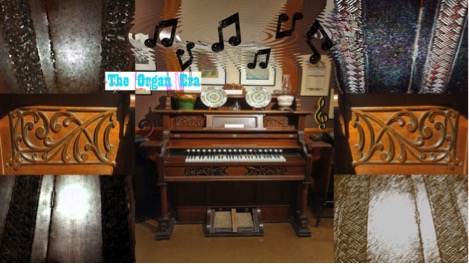Wood and Elegance: the Era of Organs
This piano is classified as a reed organ. Many Canadians purchased them, through the mail order catalogue, from the T. Eaton Company, around year 1900. The manufacturer of this instrument was Bell Piano & Organ Co. LTD., from Guelph, Ontario. These instruments were considered major exports.
 The black, sharp and flat, keys are made of dark and dense wood called ebony. Ebony is naturally black; however, it can have white traces throughout. Ethical sourcing of ebony has become more common by manufacturers, as historically it has been discarded if the ebony not perfectly black. Today, many companies use the whole ebony tree in production. The World Resource Institute indicates only 1 in 10 ebony trees produce perfectly black wood.
The black, sharp and flat, keys are made of dark and dense wood called ebony. Ebony is naturally black; however, it can have white traces throughout. Ethical sourcing of ebony has become more common by manufacturers, as historically it has been discarded if the ebony not perfectly black. Today, many companies use the whole ebony tree in production. The World Resource Institute indicates only 1 in 10 ebony trees produce perfectly black wood.
The instrument has fancy carvings, giving a traditional look. Ornate wood and reed buttons labeled in Latin, English, and Italian add to its elegance. Strange mechanics underneath the piano endorse a sense of security and control. The foot pedals are supposedly “mouse proof” and were used to power the instrument. An individual would continually pump both pedals, to create the airflow needed for the organ’s reeds. The buttons above the keys are pull cords; these devices provided different sound modifications for player preference. This particular organ is unique, in that there are drink coasters attached to both sides.
Some bands that added the reed organ to their repertoire include: The Beatles[1], Elton John, and Pink Floyd[2]. The reed organ is very popular in India and Pakistan, to the extent that modifications have endured.[3]Modifications encompass drone stops and scale-changing conformities. The popularization of reed organs in the middle-eastern region may have arisen from the exotic and elegant designs associated with them. Visit Lake Country Museum, and see for yourself!
[1]The Beatles as Musicians: The Quarry Men through Rubber Soul
[2]Wikipedia
[3]Wikipedia







lakecountry
Good to see you’ve got the CAPTCHA code working for you, Jim.